Yongjun Xu
CBPNet: A Continual Backpropagation Prompt Network for Alleviating Plasticity Loss on Edge Devices
Sep 19, 2025Abstract:To meet the demands of applications like robotics and autonomous driving that require real-time responses to dynamic environments, efficient continual learning methods suitable for edge devices have attracted increasing attention. In this transition, using frozen pretrained models with prompts has become a mainstream strategy to combat catastrophic forgetting. However, this approach introduces a new critical bottleneck: plasticity loss, where the model's ability to learn new knowledge diminishes due to the frozen backbone and the limited capacity of prompt parameters. We argue that the reduction in plasticity stems from a lack of update vitality in underutilized parameters during the training process. To this end, we propose the Continual Backpropagation Prompt Network (CBPNet), an effective and parameter efficient framework designed to restore the model's learning vitality. We innovatively integrate an Efficient CBP Block that counteracts plasticity decay by adaptively reinitializing these underutilized parameters. Experimental results on edge devices demonstrate CBPNet's effectiveness across multiple benchmarks. On Split CIFAR-100, it improves average accuracy by over 1% against a strong baseline, and on the more challenging Split ImageNet-R, it achieves a state of the art accuracy of 69.41%. This is accomplished by training additional parameters that constitute less than 0.2% of the backbone's size, validating our approach.
$\text{S}^2$Q-VDiT: Accurate Quantized Video Diffusion Transformer with Salient Data and Sparse Token Distillation
Aug 06, 2025Abstract:Diffusion transformers have emerged as the mainstream paradigm for video generation models. However, the use of up to billions of parameters incurs significant computational costs. Quantization offers a promising solution by reducing memory usage and accelerating inference. Nonetheless, we observe that the joint modeling of spatial and temporal information in video diffusion models (V-DMs) leads to extremely long token sequences, which introduces high calibration variance and learning challenges. To address these issues, we propose \textbf{$\text{S}^2$Q-VDiT}, a post-training quantization framework for V-DMs that leverages \textbf{S}alient data and \textbf{S}parse token distillation. During the calibration phase, we identify that quantization performance is highly sensitive to the choice of calibration data. To mitigate this, we introduce \textit{Hessian-aware Salient Data Selection}, which constructs high-quality calibration datasets by considering both diffusion and quantization characteristics unique to V-DMs. To tackle the learning challenges, we further analyze the sparse attention patterns inherent in V-DMs. Based on this observation, we propose \textit{Attention-guided Sparse Token Distillation}, which exploits token-wise attention distributions to emphasize tokens that are more influential to the model's output. Under W4A6 quantization, $\text{S}^2$Q-VDiT achieves lossless performance while delivering $3.9\times$ model compression and $1.3\times$ inference acceleration. Code will be available at \href{https://github.com/wlfeng0509/s2q-vdit}{https://github.com/wlfeng0509/s2q-vdit}.
Merlin: Multi-View Representation Learning for Robust Multivariate Time Series Forecasting with Unfixed Missing Rates
Jun 14, 2025Abstract:Multivariate Time Series Forecasting (MTSF) involves predicting future values of multiple interrelated time series. Recently, deep learning-based MTSF models have gained significant attention for their promising ability to mine semantics (global and local information) within MTS data. However, these models are pervasively susceptible to missing values caused by malfunctioning data collectors. These missing values not only disrupt the semantics of MTS, but their distribution also changes over time. Nevertheless, existing models lack robustness to such issues, leading to suboptimal forecasting performance. To this end, in this paper, we propose Multi-View Representation Learning (Merlin), which can help existing models achieve semantic alignment between incomplete observations with different missing rates and complete observations in MTS. Specifically, Merlin consists of two key modules: offline knowledge distillation and multi-view contrastive learning. The former utilizes a teacher model to guide a student model in mining semantics from incomplete observations, similar to those obtainable from complete observations. The latter improves the student model's robustness by learning from positive/negative data pairs constructed from incomplete observations with different missing rates, ensuring semantic alignment across different missing rates. Therefore, Merlin is capable of effectively enhancing the robustness of existing models against unfixed missing rates while preserving forecasting accuracy. Experiments on four real-world datasets demonstrate the superiority of Merlin.
Q-VDiT: Towards Accurate Quantization and Distillation of Video-Generation Diffusion Transformers
May 28, 2025Abstract:Diffusion transformers (DiT) have demonstrated exceptional performance in video generation. However, their large number of parameters and high computational complexity limit their deployment on edge devices. Quantization can reduce storage requirements and accelerate inference by lowering the bit-width of model parameters. Yet, existing quantization methods for image generation models do not generalize well to video generation tasks. We identify two primary challenges: the loss of information during quantization and the misalignment between optimization objectives and the unique requirements of video generation. To address these challenges, we present Q-VDiT, a quantization framework specifically designed for video DiT models. From the quantization perspective, we propose the Token-aware Quantization Estimator (TQE), which compensates for quantization errors in both the token and feature dimensions. From the optimization perspective, we introduce Temporal Maintenance Distillation (TMD), which preserves the spatiotemporal correlations between frames and enables the optimization of each frame with respect to the overall video context. Our W3A6 Q-VDiT achieves a scene consistency of 23.40, setting a new benchmark and outperforming current state-of-the-art quantization methods by 1.9$\times$. Code will be available at https://github.com/cantbebetter2/Q-VDiT.
BLAST: Balanced Sampling Time Series Corpus for Universal Forecasting Models
May 23, 2025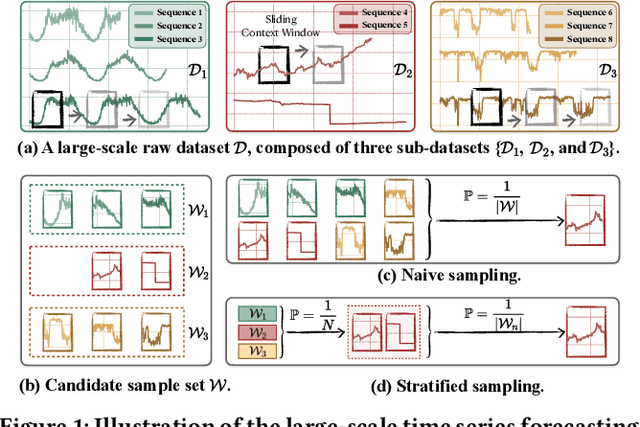
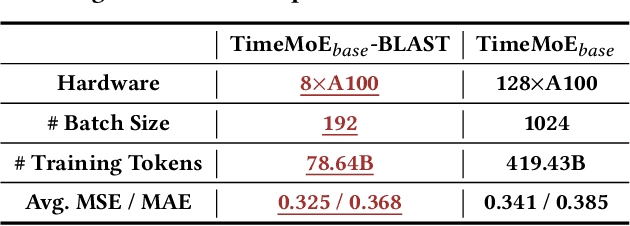
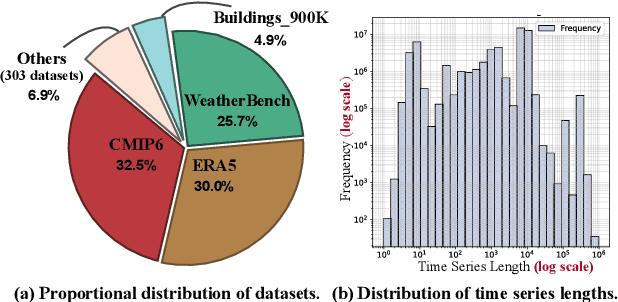
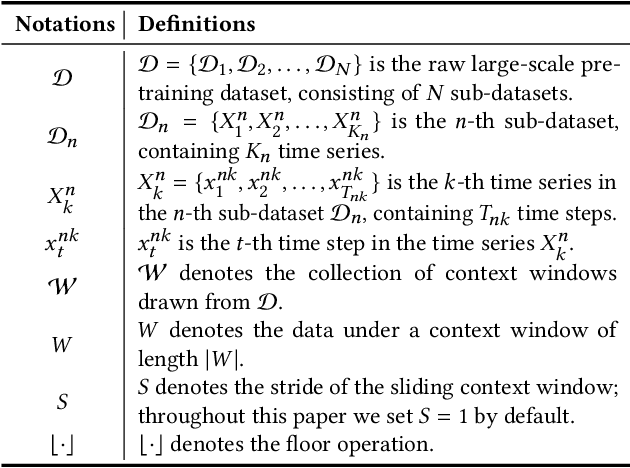
Abstract:The advent of universal time series forecasting models has revolutionized zero-shot forecasting across diverse domains, yet the critical role of data diversity in training these models remains underexplored. Existing large-scale time series datasets often suffer from inherent biases and imbalanced distributions, leading to suboptimal model performance and generalization. To address this gap, we introduce BLAST, a novel pre-training corpus designed to enhance data diversity through a balanced sampling strategy. First, BLAST incorporates 321 billion observations from publicly available datasets and employs a comprehensive suite of statistical metrics to characterize time series patterns. Then, to facilitate pattern-oriented sampling, the data is implicitly clustered using grid-based partitioning. Furthermore, by integrating grid sampling and grid mixup techniques, BLAST ensures a balanced and representative coverage of diverse patterns. Experimental results demonstrate that models pre-trained on BLAST achieve state-of-the-art performance with a fraction of the computational resources and training tokens required by existing methods. Our findings highlight the pivotal role of data diversity in improving both training efficiency and model performance for the universal forecasting task.
SifterNet: A Generalized and Model-Agnostic Trigger Purification Approach
May 20, 2025Abstract:Aiming at resisting backdoor attacks in convolution neural networks and vision Transformer-based large model, this paper proposes a generalized and model-agnostic trigger-purification approach resorting to the classic Ising model. To date, existing trigger detection/removal studies usually require to know the detailed knowledge of target model in advance, access to a large number of clean samples or even model-retraining authorization, which brings the huge inconvenience for practical applications, especially inaccessible to target model. An ideal countermeasure ought to eliminate the implanted trigger without regarding whatever the target models are. To this end, a lightweight and black-box defense approach SifterNet is proposed through leveraging the memorization-association functionality of Hopfield network, by which the triggers of input samples can be effectively purified in a proper manner. The main novelty of our proposed approach lies in the introduction of ideology of Ising model. Extensive experiments also validate the effectiveness of our approach in terms of proper trigger purification and high accuracy achievement, and compared to the state-of-the-art baselines under several commonly-used datasets, our SiferNet has a significant superior performance.
PrePrompt: Predictive prompting for class incremental learning
May 13, 2025Abstract:Class Incremental Learning (CIL) based on pre-trained models offers a promising direction for open-world continual learning. Existing methods typically rely on correlation-based strategies, where an image's classification feature is used as a query to retrieve the most related key prompts and select the corresponding value prompts for training. However, these approaches face an inherent limitation: fitting the entire feature space of all tasks with only a few trainable prompts is fundamentally challenging. We propose Predictive Prompting (PrePrompt), a novel CIL framework that circumvents correlation-based limitations by leveraging pre-trained models' natural classification ability to predict task-specific prompts. Specifically, PrePrompt decomposes CIL into a two-stage prediction framework: task-specific prompt prediction followed by label prediction. While theoretically appealing, this framework risks bias toward recent classes due to missing historical data for older classifier calibration. PrePrompt then mitigates this by incorporating feature translation, dynamically balancing stability and plasticity. Experiments across multiple benchmarks demonstrate PrePrompt's superiority over state-of-the-art prompt-based CIL methods. The code will be released upon acceptance.
A Nonlinear Hash-based Optimization Method for SpMV on GPUs
Apr 11, 2025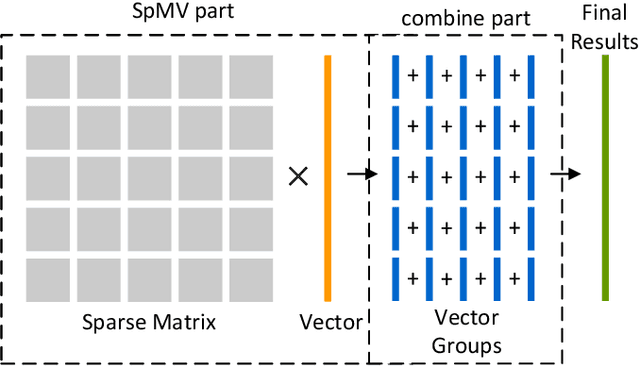
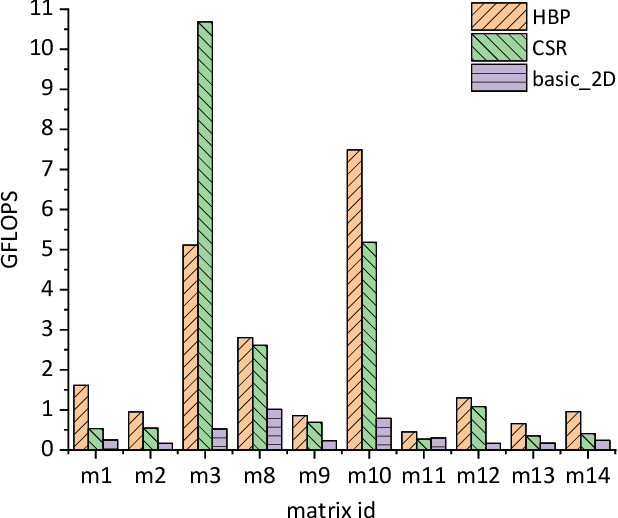
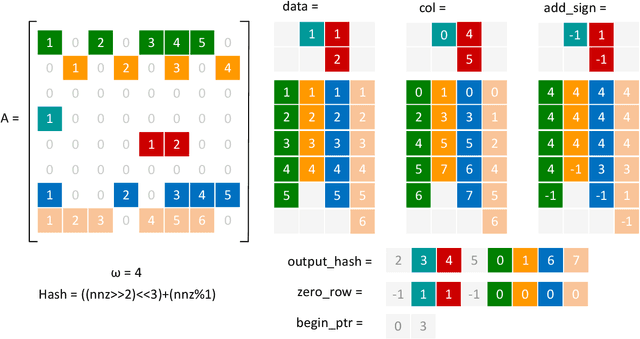

Abstract:Sparse matrix-vector multiplication (SpMV) is a fundamental operation with a wide range of applications in scientific computing and artificial intelligence. However, the large scale and sparsity of sparse matrix often make it a performance bottleneck. In this paper, we highlight the effectiveness of hash-based techniques in optimizing sparse matrix reordering, introducing the Hash-based Partition (HBP) format, a lightweight SpMV approach. HBP retains the performance benefits of the 2D-partitioning method while leveraging the hash transformation's ability to group similar elements, thereby accelerating the pre-processing phase of sparse matrix reordering. Additionally, we achieve parallel load balancing across matrix blocks through a competitive method. Our experiments, conducted on both Nvidia Jetson AGX Orin and Nvidia RTX 4090, show that in the pre-processing step, our method offers an average speedup of 3.53 times compared to the sorting approach and 3.67 times compared to the dynamic programming method employed in Regu2D. Furthermore, in SpMV, our method achieves a maximum speedup of 3.32 times on Orin and 3.01 times on RTX4090 against the CSR format in sparse matrices from the University of Florida Sparse Matrix Collection.
Efficient Continual Learning through Frequency Decomposition and Integration
Mar 28, 2025Abstract:Continual learning (CL) aims to learn new tasks while retaining past knowledge, addressing the challenge of forgetting during task adaptation. Rehearsal-based methods, which replay previous samples, effectively mitigate forgetting. However, research on enhancing the efficiency of these methods, especially in resource-constrained environments, remains limited, hindering their application in real-world systems with dynamic data streams. The human perceptual system processes visual scenes through complementary frequency channels: low-frequency signals capture holistic cues, while high-frequency components convey structural details vital for fine-grained discrimination. Inspired by this, we propose the Frequency Decomposition and Integration Network (FDINet), a novel framework that decomposes and integrates information across frequencies. FDINet designs two lightweight networks to independently process low- and high-frequency components of images. When integrated with rehearsal-based methods, this frequency-aware design effectively enhances cross-task generalization through low-frequency information, preserves class-specific details using high-frequency information, and facilitates efficient training due to its lightweight architecture. Experiments demonstrate that FDINet reduces backbone parameters by 78%, improves accuracy by up to 7.49% over state-of-the-art (SOTA) methods, and decreases peak memory usage by up to 80%. Additionally, on edge devices, FDINet accelerates training by up to 5$\times$.
Multi-Teacher Knowledge Distillation with Reinforcement Learning for Visual Recognition
Feb 22, 2025Abstract:Multi-teacher Knowledge Distillation (KD) transfers diverse knowledge from a teacher pool to a student network. The core problem of multi-teacher KD is how to balance distillation strengths among various teachers. Most existing methods often develop weighting strategies from an individual perspective of teacher performance or teacher-student gaps, lacking comprehensive information for guidance. This paper proposes Multi-Teacher Knowledge Distillation with Reinforcement Learning (MTKD-RL) to optimize multi-teacher weights. In this framework, we construct both teacher performance and teacher-student gaps as state information to an agent. The agent outputs the teacher weight and can be updated by the return reward from the student. MTKD-RL reinforces the interaction between the student and teacher using an agent in an RL-based decision mechanism, achieving better matching capability with more meaningful weights. Experimental results on visual recognition tasks, including image classification, object detection, and semantic segmentation tasks, demonstrate that MTKD-RL achieves state-of-the-art performance compared to the existing multi-teacher KD works.
 Add to Chrome
Add to Chrome Add to Firefox
Add to Firefox Add to Edge
Add to Edge